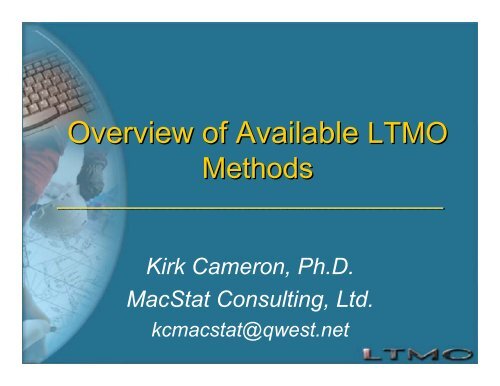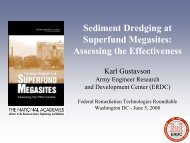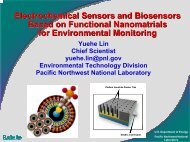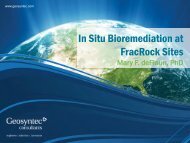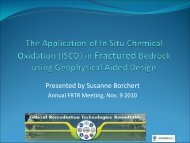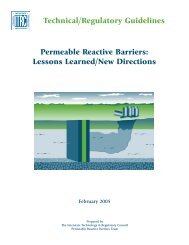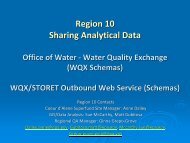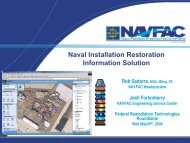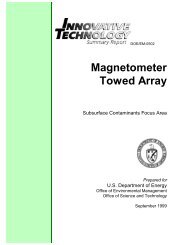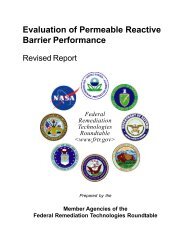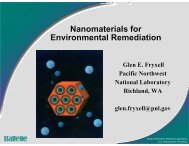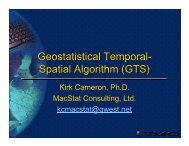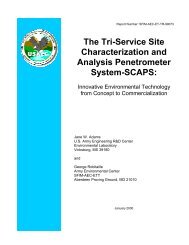Overview of Available LTMO Methods
Overview of Available LTMO Methods
Overview of Available LTMO Methods
You also want an ePaper? Increase the reach of your titles
YUMPU automatically turns print PDFs into web optimized ePapers that Google loves.
<strong>Overview</strong> <strong>of</strong> <strong>Available</strong> <strong>LTMO</strong><br />
<strong>Methods</strong><br />
Kirk Cameron, Ph.D.<br />
MacStat Consulting, Ltd.<br />
kcmacstat@qwest.net
<strong>Overview</strong><br />
• Definitions; “Big Picture”<br />
• Considerations when doing:<br />
– Qualitative reviews<br />
– Quantitative analyses<br />
• Quantitative optimization approaches<br />
• How qualitative & quantitative approaches<br />
fit together<br />
2
Definitions<br />
• Qualitative Evaluation<br />
– Using technical expertise, pr<strong>of</strong>essional judgment to<br />
assess LTM programs<br />
• Quantitative Evaluation<br />
– Using statistical, numerical analysis to assess LTM<br />
programs<br />
• What are we evaluating?<br />
– Temporal analysis: frequency <strong>of</strong> sampling<br />
– Spatial analysis: network <strong>of</strong> monitoring points<br />
– Relative importance <strong>of</strong> individual wells<br />
3
<strong>LTMO</strong> “Big Picture”<br />
Roadmap to Site Closure<br />
Characterization<br />
MW Sampling<br />
Network<br />
Remediation<br />
LTM<br />
Initial Design<br />
Validate<br />
Adjust<br />
Exit Strategy<br />
-DQOs Met<br />
-Goals Achieved<br />
Review<br />
5 Yr<br />
LTM<br />
Optimized<br />
Site Closure<br />
LTM<br />
Complete<br />
4
<strong>LTMO</strong> Major Components<br />
General Process<br />
Validation &<br />
5 Yr Review<br />
Decision<br />
Framework<br />
Data Mgmt<br />
•Legacy Data<br />
•Current Data<br />
Reporting<br />
Tool<br />
Inventory<br />
Cost<br />
Analysis<br />
Regulatory<br />
Buy-in<br />
Optimized<br />
Network<br />
Qualitative<br />
Analysis<br />
Temporal<br />
Analysis<br />
Network<br />
Expansion<br />
Network<br />
Reduction<br />
Spatial<br />
Analysis<br />
5
Qualitative Starting Point<br />
6<br />
• Understand GW & contaminant flow paths (present<br />
& future)<br />
– Rate & direction <strong>of</strong> advective transport (in 3-D)<br />
– Mobility & fate <strong>of</strong> contaminants<br />
• Conceptual site model (CSM):<br />
– CSM includes:<br />
• Nature & extent <strong>of</strong> site contaminants<br />
• Fate & paths <strong>of</strong> COCs to reach receptors<br />
• Nature & location <strong>of</strong> possible receptors<br />
• Effects <strong>of</strong> current or planned remediation activities<br />
• Future conditions (e.g., land use)<br />
–Verifycurrent CSM consistent with data recently collected<br />
as part <strong>of</strong> LTM
Qualitative Considerations<br />
• Look at Sampling Frequency/Location<br />
– GW – monitoring wells, extraction wells<br />
– Surface water, air<br />
– Treatment plant<br />
• Consider other aspects<br />
– Analytical & sampling methods<br />
– Data management<br />
– Visualization approach<br />
– Project-specific public or other stakeholder concerns<br />
7
Qualitative Considerations (cont.)<br />
• Temporal analysis – experienced pr<strong>of</strong>essional<br />
recommends sampling frequency based on:<br />
– Frequency <strong>of</strong> data assessment by project team<br />
• How <strong>of</strong>ten does the team assess the data?<br />
– Rate <strong>of</strong> contaminant migration<br />
• Usually, faster = more frequent sampling<br />
– Rate / nature <strong>of</strong> contaminant concentration change<br />
• Concentration trend slope, variability in concentrations<br />
– Time lag before action if monitoring indicates a<br />
problem<br />
– Public concerns / regulatory requirements<br />
8
Example Qualitative Logic for<br />
Optimization <strong>of</strong> Sampling Frequency<br />
Reasons for<br />
Increasing Sampling Frequency<br />
Ground water velocity is high<br />
Change in concentration would<br />
significantly alter a decision or<br />
course <strong>of</strong> action<br />
Well is close to source area or<br />
operating remedy<br />
Cannot predict if concentrations<br />
will change significantly over time<br />
Reasons for<br />
Decreasing Sampling Frequency<br />
Ground water velocity is low<br />
Change in concentration would not<br />
significantly alter a decision or<br />
course <strong>of</strong> action<br />
Well is farther from source area or<br />
operating remedy<br />
Concentrations are not expected to<br />
change significantly over time, or<br />
contaminant levels have met<br />
standards for some period <strong>of</strong> time<br />
9
Qualitative Considerations (cont.)<br />
• Spatial analysis - experienced pr<strong>of</strong>essional<br />
recommends sampling locations based on:<br />
– Use <strong>of</strong> well as sentinel for exposure point<br />
– Past well performance (goes dry, poor<br />
construction)<br />
– Proximity to other wells in same aquifer<br />
– Proximity to known plume boundary<br />
• Near source for assessing impact <strong>of</strong> source control<br />
• Near leading edge <strong>of</strong> plume (lateral & vertical) to<br />
assess migration / capture<br />
10
Qualitative Considerations (cont.)<br />
• Other spatial considerations<br />
– Compliance point well?<br />
– Is well used to define BG?<br />
– Does well have long sampling history?<br />
– Identified data gaps<br />
11
Example Qualitative Logic for<br />
Spatial Optimization<br />
Reasons for Retaining or<br />
Adding a Well<br />
Well is needed to further<br />
characterize site, monitor<br />
concentration changes over time<br />
Well important for defining lateral<br />
or vertical extent <strong>of</strong> contaminants<br />
Well is needed to monitor water<br />
quality at a compliance point or<br />
receptor exposure point<br />
Well is important for defining<br />
background water quality<br />
Reasons for Removing a Well<br />
From a Monitoring Network<br />
Well provides spatially redundant<br />
information with a neighboring well<br />
(same constituents, short distance)<br />
Well has been dry for more than<br />
two years<br />
Contaminant concentrations are<br />
consistently below laboratory<br />
detection limits or cleanup goals<br />
Well is completed in same waterbearing<br />
zone as nearby well(s)<br />
12
Quantitative <strong>LTMO</strong> Approaches<br />
• Application <strong>of</strong> numerical and/or statistical<br />
techniques to <strong>LTMO</strong>:<br />
– Sampling frequency for existing wells/points<br />
– Sampling locations<br />
– Filling data gaps<br />
• Provides degree <strong>of</strong> objectivity and<br />
repeatability<br />
• Requires familiarity with statistical methods,<br />
some specialized expertise<br />
13
Quantitative Approaches (cont.)<br />
• Sample frequency – quantitative temporal<br />
analysis<br />
– Evaluate nature & strength <strong>of</strong> statistical trend<br />
• Compute measure <strong>of</strong> variability, periodicity<br />
– Rule-based decision tree to recommend<br />
sampling frequency based on trend,<br />
variability, average concentration<br />
– Simulation approach – recommend sampling<br />
frequency based on observed & projected<br />
rate <strong>of</strong> concentration change<br />
14
Quantitative Approaches (cont.)<br />
• Sample network optimization – quantitative<br />
spatial analysis<br />
– Ranking approaches<br />
• Use geostatistical or other weighting techniques to evaluate<br />
contribution <strong>of</strong> each well to plume definition<br />
• Identify areas <strong>of</strong> high uncertainty<br />
– Simulation approaches<br />
• Combine transport simulations with numerical optimization<br />
algorithms to minimize error in plume definition<br />
• Consider impact <strong>of</strong> additional well locations<br />
– Wells that contribute little are candidates for removal<br />
– Identify areas for additional wells<br />
15
Quantitative <strong>LTMO</strong>:<br />
What Is the Opportunity?<br />
• <strong>LTMO</strong> case studies demonstrate redundancy in<br />
well networks<br />
• Typical LTM sampling effort can be reduced by<br />
20% – 40%<br />
• <strong>LTMO</strong> focuses on essential data<br />
– Tolerable uncertainty in environmental decisionmaking<br />
accepted<br />
• Helps to improve & simplify LTM programs<br />
16
Quantitative <strong>LTMO</strong> Involves<br />
Spatial Comparisons<br />
009 010 011 013 012 007 ⏐22 ⏐eafb.tce.t1.cut8.map-XY<br />
⏐eafb.tce.t1.cut9.map-XY<br />
⏐eafb.tce.t1.cut10.map-XY<br />
⏐eafb.tce.t1.cut11.map-XY<br />
⏐eafb.tce.t1.cut6.map-XY<br />
eafb.tce.t1.cut12.map-XY<br />
Frame 008<br />
006<br />
003 002<br />
004 ⏐22 Oct 2003 005 ⏐eafb.tce.t1.cut4.map-XY<br />
⏐eafb.tce.t1.cut5.map-XY<br />
Frame 001 ⏐ Oct 2003⏐ ⏐eafb.tce.t1.cut3.map-XY<br />
⏐eafb.tce.t1.cut0.map-XY<br />
eafb.tce.t1.cut7.map-XY<br />
eafb.tce.t1.cut2.map-XY<br />
eafb.tce.t1.cut1.map-XY<br />
All Wells<br />
Well Reduction 40%<br />
Frame 001 ⏐ 7 Jun 2004 ⏐ eafb.tce.t1.cut6.map-XY<br />
Site 133: TCE Concentrations (ppb), 1999-2000, Base Map<br />
Site 133: TCE Concentrations (ppb), 1999-2000, 40% Removal<br />
216.3<br />
216.2<br />
216.1<br />
Northing (10,000 ft)<br />
Y<br />
17<br />
216<br />
215.9<br />
215.8<br />
215.7<br />
215.6<br />
215.5<br />
215.4<br />
215.3<br />
215.2<br />
215.2<br />
215.1<br />
215.1<br />
665.5 666<br />
665.5 666<br />
666<br />
X<br />
Easting (10,000 ft)<br />
MEAN;RAW<br />
3000<br />
3000<br />
2000<br />
2000<br />
1000<br />
1000<br />
500<br />
500<br />
500<br />
100 100<br />
100<br />
50 50<br />
50<br />
55<br />
Northing (10,000 ft)<br />
216.3<br />
216.2<br />
216.1<br />
216<br />
215.9<br />
215.8<br />
215.7<br />
215.6<br />
215.5<br />
215.4<br />
215.3<br />
215.2<br />
215.1<br />
665.5 666<br />
Easting (10,000 ft)<br />
MEAN;RAW<br />
3000<br />
2000<br />
1000<br />
500<br />
100<br />
50<br />
5
Quantitative <strong>LTMO</strong> Involves<br />
Temporal Comparisons<br />
300<br />
“Nice to have”<br />
All Data<br />
Samples = 240<br />
“Essential”<br />
90% Reduction<br />
Samples = 27<br />
TCE (ug/L)<br />
TCE (ug/L)<br />
200<br />
100<br />
0<br />
93 94 95 96 97 98 99<br />
300<br />
YEAR<br />
Tolerable Uncertainty<br />
200 Without Loss <strong>of</strong> Information<br />
100<br />
Redundancy<br />
0<br />
93 94 95 96 97 98 99<br />
YEAR<br />
18
19<br />
What’s Out There?
What is MAROS?<br />
Monitoring<br />
and<br />
Remediation<br />
Optimization<br />
S<strong>of</strong>tware<br />
• MS Access Database application<br />
YES<br />
• Simple statistical and heuristic tools<br />
• Not mathematical optimization<br />
• Modular<br />
• Simple database input<br />
• Employed after site characterization<br />
and remediation activities are largely<br />
complete<br />
20
Limitations <strong>of</strong> MAROS<br />
• Site modeled as a single plume<br />
• Two-dimensional analysis<br />
• Different units analyzed separately<br />
• Multiple sources analyzed separately<br />
• Simplifies and consolidates data<br />
• Does not evaluate plume<br />
outside <strong>of</strong> current network<br />
• Does not include purely regulatory requirements<br />
21
MAROS Modules<br />
• Database Input:<br />
• Automated Data<br />
Consolidation<br />
• Optimization Tools:<br />
– Plume Trend<br />
Analysis<br />
– Moment<br />
Analysis<br />
– Well<br />
Redundancy<br />
– Well Sufficiency<br />
– Sample<br />
Frequency<br />
– Data Sufficiency<br />
22
Data Input & Data Reduction<br />
Well Network Input<br />
Data:<br />
• Source Wells<br />
(DNAPL)<br />
• Tail Wells<br />
• Extraction Wells<br />
Data Consolidation:<br />
• Non-detect values<br />
set to minimum or<br />
1/2 detection limit.<br />
• Average Duplicates<br />
• Trace Values set<br />
to actual values<br />
• Time Consolidation<br />
23
Plume Characterization<br />
Characterization <strong>of</strong> plume assumed to be<br />
complete<br />
• Seasonality known<br />
• Hydrology is known<br />
• Significant COCs known<br />
• Source areas known<br />
MAROS reveals broad trends; individual<br />
data points less significant<br />
24
Uses Delaunay Triangulation<br />
Well Redundancy and Sufficiency Analysis<br />
Delaunay Method:<br />
- Eliminate “redundant” wells<br />
OR<br />
- Add wells in areas with high<br />
concentration uncertainty<br />
Source Zone<br />
Tail Zone<br />
KEY POINT: Does estimated<br />
concentration change if well is removed?<br />
25
Geostatistical Temporal-Spatial<br />
(GTS) Algorithm<br />
• Emphasizes decision-logic framework<br />
• “Plug-in” architecture<br />
• Uses ‘semi-objective’ geostatistical and trend<br />
optimization methods<br />
– Variogram = spatial correlation measure<br />
– Locally-Weighted Quadratic Regression (LWQR)<br />
• Used for both spatial regression & fitting time series trends<br />
• Prototype s<strong>of</strong>tware available end <strong>of</strong> May 2005<br />
26
GTS Temporal Analysis<br />
• Flexible strategies for optimizing sampling<br />
frequencies<br />
– Individual well analysis; “iterative thinning”<br />
– Temporal variogram for well groups & broad<br />
areas<br />
27
Iterative Thinning<br />
• Individual well analysis<br />
– Estimate baseline trend<br />
– Randomly “weed out” data points<br />
– Re-estimate trend<br />
– Assess significant departure from baseline<br />
28
Iterative Thinning Example<br />
Concentration (ppb)<br />
250<br />
200<br />
150<br />
100<br />
MN: Well 399-1-10A<br />
Upper 90% Conf. Bnd.<br />
Lower 90% Conf. Bnd.<br />
Initial Fit<br />
Med. Fit (0.45)<br />
Med. Fit (0.50)<br />
UQ Fit (0.50)<br />
LQ Fit (0.50)<br />
Sample Conc.<br />
50<br />
0<br />
7/23/90 11/23/96 3/26/03<br />
Sampling Date<br />
29
Iterative Thinning Details<br />
• At least 8 sampling events per well<br />
• NDs set to common imputed value<br />
• Complex trends, seasonal patterns OK<br />
– LWQR fits non-linear trends<br />
• Median optimized interval can be used to set<br />
operational sampling schedule<br />
30
Iterative Thinning Summary<br />
90<br />
80<br />
70<br />
60<br />
50<br />
40<br />
30<br />
20<br />
10<br />
0<br />
N Wells<br />
LQ<br />
Median<br />
UQ<br />
25<br />
24 wks<br />
47 wks<br />
67 wks<br />
31
GTS Spatial Analysis<br />
• Uses Locally-Weighted Quadratic<br />
Regression (LWQR) to build maps<br />
– Create base map first<br />
– Iteratively remove wells that least change<br />
base map<br />
• Track bias, uncertainty<br />
–Construct cost-accuracy trade<strong>of</strong>f curves<br />
32
33<br />
Base Map Example
34<br />
Cost-Accuracy Curves
Spatial Analysis (cont.)<br />
• LWQR Benefits<br />
– Smoothing technique, not an interpolator<br />
– Robust; does not assume or require a spatial<br />
covariance model (variogram)<br />
– Can handle highly-skewed data<br />
– Handles multiple values in time and space<br />
35
GTS Spatial Details<br />
• At least 20-30 regularly-monitored wells<br />
– Irregular sampling schedules OK<br />
• Best COCs have:<br />
– Higher detection frequencies<br />
– Greater spatial spread & intensity<br />
• Good to have 2-3 years <strong>of</strong> most recent<br />
monitoring data at each well<br />
36
Parsons’ 3-Tiered <strong>LTMO</strong> At A<br />
Glance<br />
3-Tiered Monitoring Well Network<br />
Optimization<br />
Establish Baseline<br />
Data<br />
Compilation<br />
Site Screening<br />
Qualitative<br />
Evaluation<br />
Temporal<br />
Statistical Analysis<br />
Spatial<br />
Statistical Analysis<br />
Monitoring Distribution & Frequency<br />
Recommendations<br />
37
3-Tiered <strong>LTMO</strong> Strategy<br />
• Qualitative Evaluation<br />
– Experienced geologist<br />
big-picture analysis<br />
• Temporal Statistical<br />
Evaluation<br />
– Mann Kendall trend analysis<br />
• Spatial Statistical Evaluation<br />
– Geostatisical Kriging relative<br />
predicted error analysis<br />
3-Tiered <strong>LTMO</strong><br />
Analysis<br />
Combines three<br />
evaluations to optimize<br />
the distribution and<br />
frequency <strong>of</strong> ground<br />
water sampling.<br />
38
3-Tiered Approach<br />
Qualitative Evaluation<br />
39<br />
• DATA<br />
– Site characterization<br />
– Monitoring results<br />
– Monitoring Network DQOs, etc.<br />
• INFORMATION<br />
– Value <strong>of</strong> each well in big picture<br />
context<br />
• SOLUTION<br />
– Recommend:<br />
• Well retention or removal<br />
• Optimal sampling frequency<br />
Requires<br />
Experienced<br />
Hydrogeologist<br />
Familiar With<br />
Site
3-Tiered Approach<br />
Temporal Evaluation<br />
• DATA:<br />
– >4 sampling results over time<br />
– Well/plume location & GW direction<br />
– Concentration relative to MDLs and PQLs<br />
• INFORMATION:<br />
– Mann-Kendall Trend analysis<br />
– Automated process (MAROS/GIS script)<br />
• SOLUTION:<br />
– Recommend retention or removal/reduction based on<br />
decision rationale<br />
40
41<br />
3-Tiered Approach<br />
Spatial Evaluation<br />
• DATA<br />
– Spatial “Snapshot” <strong>of</strong> Plume<br />
• Most recent chemical concs<br />
• Indicator chemical<br />
• Wells in same zone<br />
• INFORMATION<br />
– Geostatistical (Kriging) Evaluation<br />
• Develop spatial model (semivariogram)<br />
Requires<br />
Experience with<br />
Geostatistics &<br />
Semivariogram<br />
Development<br />
• Calculate Kriging predicted standard error metric for each well<br />
– Conducted Using ArcGIS Geostatistical Analyst<br />
Extension<br />
• SOLUTION<br />
– Recommend removal or retention based on relative<br />
value <strong>of</strong> spatial information <strong>of</strong> each well
<strong>LTMO</strong> Tool Selection<br />
Factors<br />
• Site conditions & existing network<br />
– Scale <strong>of</strong> network; # wells & sampling events<br />
– Single vs. multiple sites<br />
– 2D vs. 3D analysis<br />
– Single vs. multiple aquifers<br />
• Choice <strong>of</strong> spatial & temporal algorithms<br />
• Human resources & available<br />
technical expertise<br />
• Regulatory input & concurrence<br />
42
Combining Qualitative &<br />
Quantitative Approaches<br />
• Quantitative results must be reviewed<br />
qualitatively by technical staff<br />
– Consider site hydrogeology<br />
– Address stakeholder needs<br />
– Consider recent & future changes<br />
• Production & land use<br />
• Impacts <strong>of</strong> climate, other factors<br />
– Qualitative review may “trump” quantitative<br />
results<br />
43
Combining Qualitative &<br />
Quantitative<br />
• Might perform both qualitative and<br />
quantitative methods<br />
– Use rules, decision tree to adopt specific<br />
recommendations<br />
• Example: Parsons three-tiered<br />
approach<br />
44
Summary<br />
• A variety <strong>of</strong> <strong>LTMO</strong> tools are available<br />
• Many factors determine choice <strong>of</strong> tools for<br />
specific application<br />
• Multiple <strong>LTMO</strong> tools may be used over<br />
time at any given site<br />
• Key goals: Improving LTM programs &<br />
supporting environmental decisions<br />
45


